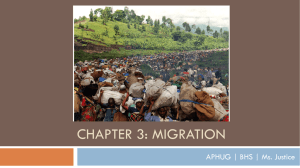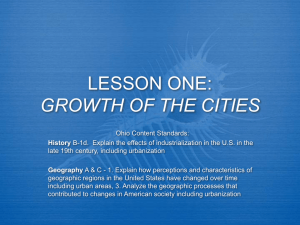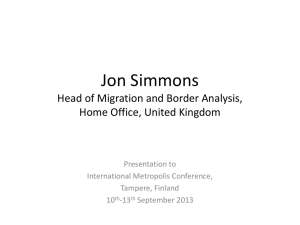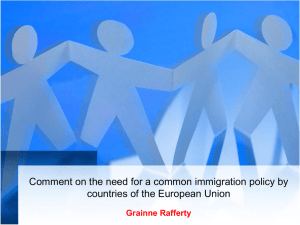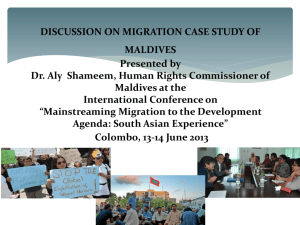Demographics Lesson 5 Powerpoint
advertisement
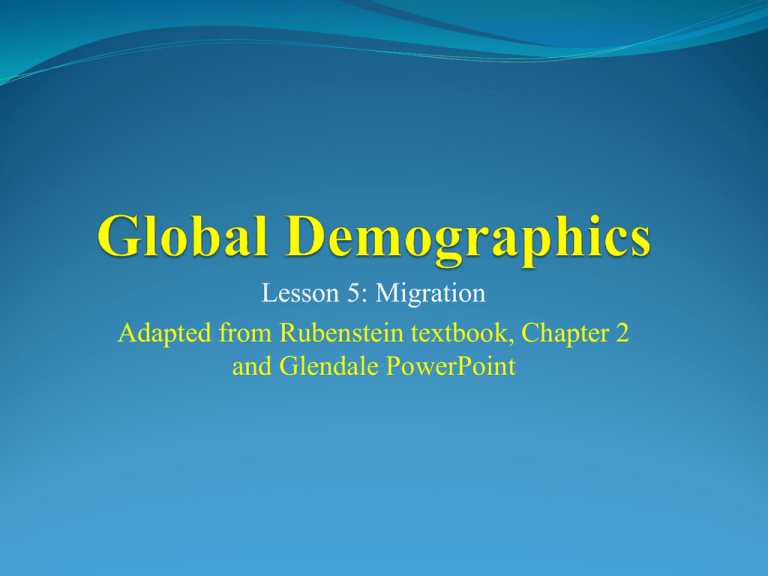
Lesson 5: Migration Adapted from Rubenstein textbook, Chapter 2 and Glendale PowerPoint Migration Today, the number of people living outside their country of birth is larger than at any other time in history. International migrants would now constitute the world's fifth most populous country if they all lived in the same place” (UNFPA). Migration – 3 Key Ideas At the end of this section you should be able to explain: 1. Why people migrate 2. Major current and past migration flows 3. Migration Challenges and Patterns Why do people migrate? Push factors: factors drive people to leave home. Lack of Jobs/Poverty: Economics provides the main reason behind migration (about half of the current migrants have left to find a better job and lifestyle for their family) Civil Strife /War: Political and Religious Persecution Environmental Problems: natural disasters, desertification, etc. Can you think of other “push” factors? Why do people migrate? Pull factors: factors attract migrants to a new location Higher standards of living/Higher wages: i.e. US-Mexico. wages are an estimated 13 times higher in the U.S. than of Mexico Labor Demand: Many developed countries rely on migrant labor for agriculture, construction, and other low-paying jobs. Political and Religious Freedom: for example, Israel was founded as a refuge for Jews who faced persecution in their countries of origin. Types of Migration Voluntary migration The migrant makes the decision to move. Most migration is voluntary. Push and Pull Factors determine whom and where. Forced Migration The migrant has no role in the decision-making process. Slavery. About 11 million African slaves were brought to the Americas between 1519 and 1867. In 1860, there were close to 4 million slaves in the United States. Today: U.S. State department estimates that there are annually 800,000 new victims of slavery world-wide. The International Labor Organization estimates 2.5 million. Unfortunately, the UN states that these numbers are only rising. Refugees. (15.2 million refugees world-wide as of 2009) Military conscription. Children of migrants. Types of Migration Spring Summer Circular migration "the fluid movement of people between countries, including temporary or long-term Fall / Winter movement which may be beneficial to all involved, if occurring voluntarily and linked to the labour needs of countries of origin and destination“ (IOM definition) Temporary or seasonal migration, usually associated with agricultural work.The migrant follows the harvest of various crops, moving from one place to another each time. Very common in the US Southwest (Mexican farm workers) and in Western Europe (Eastern European farm workers). If managed properly to ease the transition of workers to and from their origin and destination countries, policymakers view this a potential solution to current migration challenges. What do you think? Types of Migration Sojourners Workers intend to stay only until they save enough money to return to their homeland with wealth. Common in the U.S. with Italians between 1890-1910. Common now in the U.S. with workers from Latin America. Remittances are a substantial part of the economy of some migrant source countries. For example Somaliland receives about $500 million in remittances, four times the income it receives from its major export (livestock). Remittances worldwide were estimated at $414 billion in 2009. World Refugee Patterns, 2007 U.S. Immigration Prior to 1840, 90% of U.S. immigration was from Britain 1840 - 1930: W. and N. European transitioning to Southern and Eastern European by 1910 Irish (potato famine in 1840s) and Germans During 1900s: Italians, Russians, AustriaHungary (Czech, Poland, Romania, etc.) 1950 - Today: Asians and Latin Americans; declining Europeans Asians: China, India; 1980s -1990s: Philippines, Vietnam, and South Korea Latin America: Mexico, Dom. Rep., El Salvador, Cuba, Haiti 1986 Immigration Reform and Control Act admitted former illegals in 1990, 1991. Ellis Island 1911 U.S. Immigration Patterns U.S. Immigration Policies 1882, Bars Asian immigration for ten years (extended) 1921, Quota Act - country by country quotas 1924 National Origins Act - country by country quotas 1965, Immigration Act - quotas for countries replaced, in 1968, with hemisphere quotas of 170, 000 for East and 120,000 for West Relatives and family member preference begins 1978, Immigration Act - global quota of 290, 000 1980, Refugee Act - quotas do not apply to those seeking political asylum 1986, Immigration Reform and Control Act admitted large numbers of former illegals. 1990, Immigration Act raised global quotas to roughly 675,000 1995, visas begin to be issued preferentially: Relatives and family members get overwhelming priority (see next slide) Current Total (2004): 950,000 legal entries Top 10 Countries of Origin for US Legal Immigrants, 2000, 2004, 2010 Population Pyramid of Native and Foreign Born Population, U.S., 2000 (in %) Foreign Born Male Native Female Age Male Female 85+ 80- 84 75- 79 70- 74 65- 69 60- 64 55- 59 50- 54 45- 49 40- 44 35- 39 30- 34 25- 29 20- 24 15- 19 10- 14 5- 9 0- 4 8 6 4 2 0 Percent 2 4 6 8 8 6 4 2 0 2 4 Percent Slide graphic courtesy of Dr. Jean-Paul Rodrigue, Hofstra University 6 8 Interregional Migration Populations in the less developed world are rushing to cities in search of work and income. Urbanization migration from rural areas lack of jobs in countryside lack of services in cities Top Tier Cities in 2007-- Cities with over 1 million in foreign-born residents U.S.: San Francisco, Los Angeles, Dallas, Houston, Chicago, Toronto, New York, Washington, DC, and Miami Europe: London, Paris, Moscow , Middle East: Dubai, Riyadh Medina, Mecca Asia: Hong Kong, Singapore, Sydney, Melbourne Lagos, Nigeria Mumbai, India Mexico City, Mexico Migration Challenges Human Trafficking : there are 2.45 million trafficking victims who are living in exploitive conditions and another 1.2 million people who are trafficked across and within borders. Those who are unable to pay for their passage are sometimes forced to work in sweat shops or forced to prostitute themselves. Curbing human trafficking while minimizing the suffering inflicted on illegal immigrants presents a formidable challenge to governments as they devise new immigration policies. Security: Post 9/11 – the U.S. (and other countries) fear the migration of terrorists to their countries In Europe, migration and integration policies are complicated by the fact that the European Union (EU) now comprises twenty-seven member states. The concern expressed by some Europeans is that this continuous expansion of the EU will generate more immigration into Western Europe, bringing with it numerous problems, such as inadequate integration. What other challenges can you think of for developed and for developing countries?


